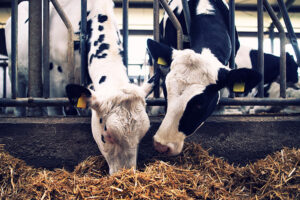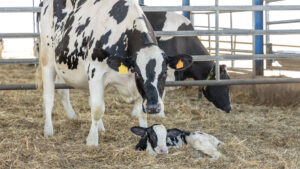By Dave Natzke, Editor, Progressive Dairyman
Audits of 95 U.S. herds found many have addressed dairy efficiency from feed processing and storage perspectives, but cow comfort remains an area needing improvement.
Results of the audits were shared at a Dairy Efficiency Summit, hosted by Papillon Agricultural Co. in mid-July in Green Bay and Madison, Wisconsin.
The company began focusing on dairy feeding efficiency about six to seven years ago, according to Dave Briggs, president. It launched a service program two years ago, called the Papillon Dairy Initiative.
The project is designed to work with dairy farmers and their nutritionists to create awareness of feeding efficiency at the farm level, and identify opportunities for economic returns, with goals of preventing over/under feeding nutrients, improving efficiency and reducing nutrient loading. The program focuses on three major areas: management, nutritional efficiency and economic efficiency.
“That focus will help us as an industry grow and make strides toward efficiency at the farm gate,” said Briggs.
Project manager Clayton Stoffel conducted about 95 farm audits over an 18-month period, nearly half in the Midwest. The audits covered about 52,000 cows in 366 pens.
Herd eligibility requirements included a willingness to share bulk tank milk information and feed weights corrected for refusals. The herds must also have been fed a total mixed ration (TMR) formulated by the nutritionist who initiated the audit.
The audit process included a pre-audit interview, followed by an on-farm management and nutrition interview, and observations of management protocols. Critical factors included such things as milking frequency, dry period length, forage analysis and moisture testing, dry matter intakes, feed delivery and push-up and group feeding strategies.
Observed management areas with potential to influence whole-herd feed efficiency included time away from the pen, stocking density, body condition, stall design, heat abatement and cow comfort, bunker face and cover management, commodity storage, water availability and bunk space.
Compliance testing included comparisons between fed and formulated TMR crude protein and phosphorus, and fecal starch and phosphorus measurements.
The audit generates a Papillon Efficiency Index, made up of management influences, compliance testing (TMR and fecal sample results) and nutrient utilization efficiency (energy, nitrogen and phosphorus).
All results were discussed with the farm’s management team and nutritionist.
Tabulating results
The focus on feeding efficiency has helped change feeding management and strategies.
“The traditional goal of feeding cows is to feed as much as possible to maximize dry matter intake and get more milk out of them,” said Stoffel. “That is limited by how much a cow can consume, how much a producer can feed and how much manure a producer can handle.”
The new goal of feed efficiency addresses those limits, while maintaining or increasing milk production.
“Producers are doing a lot of things correctly,” Stoffel said. “Most farms I have visited are doing a good job of processing their feeds. Fecal starch measurements have been low [less than 3] across most of the farms. Industry and university professionals have done an excellent job of focusing on this area.”
Another area where farms are doing things right is in mixing feed.
“The majority of feedbunks, bags and piles I looked at were well managed. In addition, when comparing TMR crude protein and formulated crude protein, two-thirds of the farms I audited had less than 5 percent difference between TMR formulated crude protein and TMR crude protein as fed. This is a sign that proper mixing, storage, sampling and feeding practices are all being used on most farms.”
The areas with room for improvement usually boiled down to cow comfort, Stoffel said.
“There are places that do a great job with cow comfort, but almost everyone could improve somewhere. One of the biggest ones was overcrowding the fresh pen. Seventy-three percent of the farms with a fresh pen I audited had more than the recommended 80 percent stocking density. It is tough to manage a pen that is in as much flux as the fresh pen is, but ensuring cows have room to lie, ruminate and eat all are critical to transitioning the rumen well and maximizing production throughout the rest of lactation.”
Heat abatement was another area in need of improvement, in many cases due to fans and sprinklers that were not turned on soon enough.
Waterers were generally clean, but water space wasn’t always adequate.
“I look at linear inches of water trough per cow in each pen, with a goal of 3 inches per cow. Only 47 percent of the 370 pens of cows I audited had adequate water trough space. One producer who added a water trough on the wall of their rapid-exit parlor saw an increase of a couple pounds of milk in the summer. Imagine if cows had adequate water in their pens as well.”
Efficiency measurements
The project’s primary goal was to identify potential efficiencies.
“I think our biggest economic opportunities lie in increasing energy efficiency,” Stoffel said. “According to the Dairy Initiative way of calculating energy efficiency, cows should fall between 70 percent and 100 percent efficient. The average across all the audits was 87 percent, but there are plenty of farms falling below 85 percent. If those farms could increase two units, up to the average, it could mean anywhere from 3,000 to 8,000 dollars of increased revenue per 100 cows per year.”
“I believe most of these improvements could be made in management and cow comfort areas,” he continued. “There may be some farms where dietary tweaks can increase efficiency, but I believe inefficiency is usually the effect of energy wasted elsewhere, because cows aren’t comfortable. About 38 percent of the variation in energy-corrected milk across the 95 farms I have audited can be explained by the management pieces I look at.”
“We also have opportunity to improve phosphorus efficiency, not so much from a bottom line standpoint, but from an environmental standpoint,” Stoffel said.
The audits revealed substantial differences in formulated phosphorus versus phosphorus levels fed to the cows, with threequarters of the herds off by more than 5 percent, and some herds overfeeding phosphorus by more than 35 percent. Failing to address that issue could result in additional phosphorus-related environmental regulations, he warned.
Originally published in the August 29, 2016 newsletter of Progressive Dairyman.





